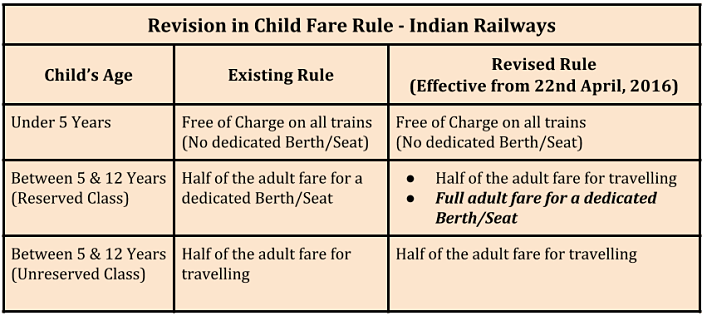[orc]The Indian Railways has announced revision of the child fare rule in reserved classes. From April 2016, passengers will have to pay the full adult fare even for children between 5 and 12 years if they opt for a dedicated berth/seat. The railways plans to achieve both additional revenue and increase in the passenger transport capacity with this move.
The Ministry of Railways has recently announced the revision of the Child Fare rule. Under the new rules to be effective from April 2016, full adult fare will be charged for children of age between 5 and 12 years if berth/seat (in reserved class) is sought at the time of reservation. But what does the Railways plan to achieve with this change?
The Existing Rule
Under the existing rules, Children under 5 years of age will be carried free of charge on all trains. Children between 5 and 12 years will be charged at half the corresponding adult fare. Even at half the adult fare, these children are entitled to a full berth/seat.
Children under 5 years of age will be provided food in Rajdhani and Shatabdi Express trains without any charge.
The Revised Rule
Under the revised rules to be effective from 22nd April, 2016, children between 5 and 12 years, for whom full berth (in reserved class) is sought at the time of reservation, full adult fare shall be charged. However at the time of reservation, if a separate berth/seat is not sought for children between 5 and 12 years, then half the adult fare will continue to be charged. In other words, this change is applicable only for those who wish to have a dedicated seat/berth for their children between 5 and 12 years in the reserved class.
This change will not have any impact on the bookings done in unreserved classes. This is logical since there is no guarantee of getting a seat/berth in unreserved classes. The Ministry of Railways data indicate that approximately 6.20 crore child passengers availed this half fare in the unreserved classes during 2014-15. The revised rules will not have any impact on them.
What does the Railways plan to achieve?
The railways plans to achieve two goals with this revision. One is to increase its revenues and the other is to increase the availability of berths without increasing the number of trains.
During 2014-15, approximately 2.11 crore child passengers availed the half fare rule in reserved classes. The revised rules will now be applicable to this category of passengers. Since the passengers will now have the option to opt for a dedicated berth for children between 5 & 12 years, the assumption is that most passengers will not opt for a dedicated berth since they have to pay the full adult fare. Even if they choose to opt for a dedicated berth, the railways will now earn additional income in the form of full adult fare instead of the half fare.
The Railways expects the revision to have the following benefits
- Potential of adding 20 million additional berths in a year for passengers without any additional input or running additional trains (since 2.1 crore child passengers availed this option in 2014-15)
- Up to 20 million additional passengers, including senior citizen and women, could travel by train on confirmed berths every year which is equivalent to about 20,000 additional trains in a year/54 additional trains in a day.
- Optimal utilization of available accommodation.
- Potential of generating additional revenue for the Railways.
The Ministry of Railways expects that this will help increase the passenger transport capacity of Indian Railways till additional line capacity works are completed to facilitate running of additional trains. The Railways expects to earn an additional 525 Crore rupees in a year due to change in this rule.
Will it work?
This is definitely a move worth appreciating. But adequate steps have to be taken to avoid claims over the age of the child, especially those below 5 years. It remains to be seen if passengers will opt for dedicated berth for their child or continue to avail the half fare rule.
Featured Image: © Jorge Royan / http://www.royan.com.ar, via Wikimedia Commons



